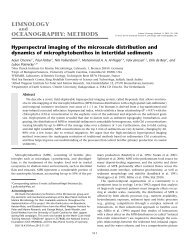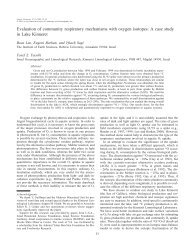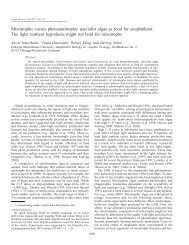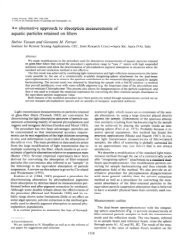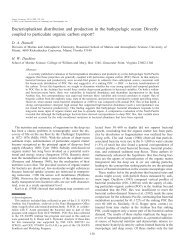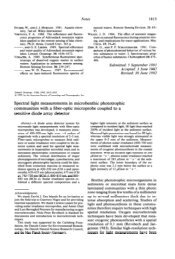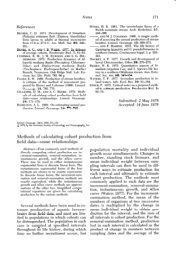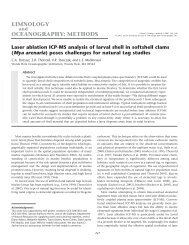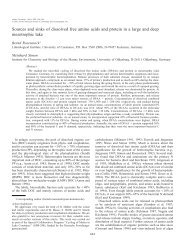Tina van de Flierdt, Katharina Pahnke, and GEOTRACES ... - ASLO
Tina van de Flierdt, Katharina Pahnke, and GEOTRACES ... - ASLO
Tina van de Flierdt, Katharina Pahnke, and GEOTRACES ... - ASLO
Create successful ePaper yourself
Turn your PDF publications into a flip-book with our unique Google optimized e-Paper software.
<strong>van</strong> <strong>de</strong> <strong>Flierdt</strong> et al. Seawater Nd Isotopes: Intercalibration<br />
Assessment <strong>and</strong> discussion of results<br />
Neodymium isotope intercalibration in seawater at BATS<br />
<strong>and</strong> SAFe<br />
To achieve comparability of results, all measured<br />
143 Nd/ 144 Nd ratios have been normalized relative to a JNdi ratio<br />
of 0.512115 (Tanaka et al. 2000) or a La Jolla ratio of 0.511858<br />
(Lugmair et al. 1983) using st<strong>and</strong>ard values reported by each<br />
laboratory (see caption of Table 2). For laboratories that routinely<br />
use other in-house st<strong>and</strong>ards than the ones listed above,<br />
their reported cross-calibration for their respective st<strong>and</strong>ards<br />
relative to JNd i /La Jolla was used. Figs. 1 <strong>and</strong> 2 <strong>and</strong> Tables 2<br />
<strong>and</strong> 3 show the results for the Nd isotopic composition of seawater<br />
at three distinct water <strong>de</strong>pths at BATS <strong>and</strong> SAFe as measured<br />
by 15 different laboratories. Sub-surface water at BATS<br />
yiel<strong>de</strong>d an average Nd isotopic composition of –9.2 ± 0.6, <strong>de</strong>ep<br />
water at BATS a value of –13.1 ± 0.6, <strong>and</strong> the average Nd isotopic<br />
composition of <strong>de</strong>ep water at SAFe is –3.2 ± 0.5 (errors:<br />
Fig. 1. Dissolved neodymium isotopic composition for two water <strong>de</strong>pths<br />
at BATS (NW Atlantic). Results display good agreement of the international<br />
community (15 individual laboratories) on measuring the Nd isotopic<br />
composition of seawater (i.e., values agree within 57 ppm; two<br />
sigma st<strong>and</strong>ard <strong>de</strong>viation of the mean). Details on samples <strong>and</strong> laboratories<br />
are given in Tables 1a <strong>and</strong> 2. Errors plotted are external two sigma<br />
st<strong>and</strong>ard <strong>de</strong>viations reported by each laboratory (based on repeat analyses<br />
of isotopic st<strong>and</strong>ards; see Table 2 caption), or internal two sigma st<strong>and</strong>ard<br />
error, <strong>de</strong>pending on which error was the larger one.<br />
240<br />
two sigma st<strong>and</strong>ard <strong>de</strong>viations of the mean). Interpretation of<br />
the results concerning comparability to published literature<br />
values can be found in the accompanying paper by <strong>Pahnke</strong> et<br />
al. (2012). Here we focus on assessing the agreement achieved<br />
between the different laboratories (i.e., reproducibility; reproducibility<br />
is here <strong>de</strong>fined as the two sigma st<strong>and</strong>ard <strong>de</strong>viation<br />
of the mean of all individual data points consi<strong>de</strong>red for a<br />
given location).<br />
The reproducibility for the three sample sets is found to be<br />
between 47 <strong>and</strong> 57 ppm. Consi<strong>de</strong>ring that the external two<br />
sigma st<strong>and</strong>ard <strong>de</strong>viation reported by each laboratory for<br />
143 Nd/ 144 Nd ratios varies between 10 <strong>and</strong> 100 ppm (see values<br />
reported on La Jolla, JNd i , or other in house st<strong>and</strong>ard runs in<br />
the caption of Tables 2 <strong>and</strong> 3), this is an excellent result. However,<br />
two thirds of all laboratories report a more narrow range<br />
of external reproducibilities between 20 <strong>and</strong> 40 ppm for their<br />
143 Nd/ 144 Nd analyses. Two questions emerge at this point: (1)<br />
Is a better agreement of natural seawater measurements possible<br />
(e.g., what is the reproducibility on natural samples compared<br />
to pure st<strong>and</strong>ard solutions <strong>and</strong> how do various methodologies<br />
feature in the statistics?), <strong>and</strong> (2) what is the reason for<br />
the larger external errors reported by some laboratories, <strong>and</strong><br />
how do their values influence the overall statistics.<br />
Starting with the first point, a simple exercise was un<strong>de</strong>rtaken<br />
to constrain whether the spread in data observed in Figs.<br />
1 <strong>and</strong> 2 is an artifact of incomplete matrix removal from natural<br />
samples during ion chromatography, <strong>and</strong> subsequent mass<br />
spectrometry, or whether the spread in 143 Nd/ 144 Nd ratios arises<br />
from the analyses themselves (i.e., different methods applied<br />
during mass spectrometry yielding different <strong>de</strong>grees of accuracy<br />
<strong>and</strong> precision). Fig. 3 illustrates results obtained for an<br />
‘unknown st<strong>and</strong>ard solution’. The st<strong>and</strong>ard was produced from<br />
Nd 2 O 3 pow<strong>de</strong>r at Imperial College London in an ultraclean lab-<br />
Fig. 2. Dissolved neodymium isotopic composition at 3 km water <strong>de</strong>pth<br />
at SAFe (NE Pacific). Results display good agreement of the international<br />
community (8 individual laboratories) on measuring the Nd isotopic composition<br />
of seawater (i.e., all values agree within 47 ppm; two sigma st<strong>and</strong>ard<br />
<strong>de</strong>viation of the mean). Details on samples <strong>and</strong> laboratories are<br />
given in Tables 1a <strong>and</strong> 3. Errors plotted are external two sigma st<strong>and</strong>ard<br />
<strong>de</strong>viations reported by each laboratory (based on repeat analyses of isotopic<br />
st<strong>and</strong>ards; see Table 3 caption).




